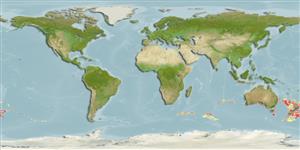Common names from other countries
Classification / Names
ชื่อสามัญ | ชื่อพ้อง | Catalog of Fishes(สกุล, ชนิด) | ITIS | CoL | WoRMS | Cloffa
subclassHolocephali (chimaeras) (chimaeras) >
Chimaeriformes (Chimaeras) >
Chimaeridae (Shortnose chimaeras or ratfishes)
Etymology: Hydrolagus: hydro-, combining form of hydor (Gr.), water; lagos (Gr.), hare, i.e., “water rabbit,” probably referring to three pairs of tooth plates, which tend to protrude from the mouth like a rabbit’s incisors. (See ETYFish); homonycteris: homo-, from hominis (L.), man; nykteris (Gr.), bat, referring to Thomas A. Griffiths, bat systematist known as “bat man,” who introduced Didier to chimaeroid fishes. (See ETYFish).
Environment: milieu / climate zone / depth range / distribution range
นิเวศวิทยา
เกี่ยวกับทะเล,น้ำเค็ม สัตว์หน้าดินในเขตน้ำลึก; ระดับความลึก 866 - 1447 m (Ref. 76967). Deep-water
Southern Ocean: Australia and New Zealand.
Length at first maturity / ขนาด / น้ำหนัก / Age
Maturity: Lm ?, range 85 - ? cm
Max length : 109 cm TL เพศผู้/กระเทย; (Ref. 76967)
Short description
เครื่องมือที่ใช้ในการแยกชนิดสัตว์,สิ่งมีชีวิตออกจากกัน | สัณฐานวิทยา | ความยาวต่างๆ
This chimaeroid fish has a ventral caudal fin that that is not indented at its origin to form a separate anal fin, it is distinguished from its congeners by the following characters: color of the body an even dark black or blackish-brown; its dorsal fin spine is longer than height of first dorsal fin; pelvic fins is distinctly round in shape; males with pelvic claspers that are dark at the base with pale tips, divided for the distal 1/3 of their length (Ref. 76967).
Life cycle and mating behavior
Maturities | การสืบพันธุ์ | Spawnings | Egg(s) | Fecundities | ตัวอ่อน
Didier, D.A., 2008. Two new species of the genus Hydrolagus Gill (Holocephali: Chimaeridae) from Australia. In Last, P.R., White, W.T. & Pogonoski, J.J. (eds.): Descriptions of New Australian Chondrichthyans. CSIRO Marine and Atmospheric Research Paper no. 22. (Ref. 76967)
IUCN Red List Status (Ref. 130435)
CITES (Ref. 128078)
Not Evaluated
Threat to humans
Harmless
Human uses
เครื่องมือ
Special reports
Download XML
แหล่งที่มาจากอินเตอร์เน็ต
Estimates based on models
Preferred temperature (Ref.
115969): 2.2 - 5.7, mean 4.6 (based on 177 cells).
Phylogenetic diversity index (Ref.
82804): PD
50 = 0.5000 [Uniqueness, from 0.5 = low to 2.0 = high].
Bayesian length-weight: a=0.00275 (0.00138 - 0.00549), b=3.08 (2.90 - 3.26), in cm Total Length, based on LWR estimates for this species & (Sub)family-body (Ref.
93245).
ระดับชั้นอาหาร (Ref.
69278): 3.9 ±0.6 se; based on size and trophs of closest relatives
ความสามารถในการกลับคืนสู่ปกติ (Ref.
120179): ต่ำมาก, เวลาต่ำสุดที่จะทำให้ประชากรเพิ่มขึ้นเป็น 2 เท่าใช้เวลามากกว่า 14 ปี (Preliminary K or Fecundity.).
Fishing Vulnerability (Ref.
59153): High to very high vulnerability (65 of 100).
